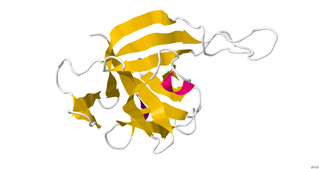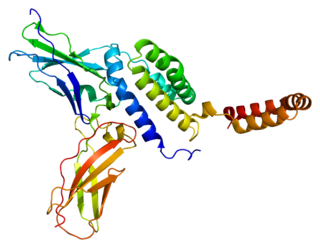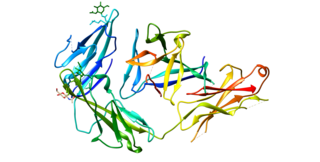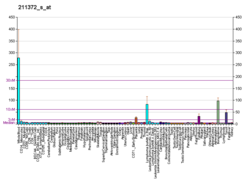
The interleukin 4 is a cytokine that induces differentiation of naive helper T cells (Th0 cells) to Th2 cells. Upon activation by IL-4, Th2 cells subsequently produce additional IL-4 in a positive feedback loop. IL-4 is produced primarily by mast cells, Th2 cells, eosinophils and basophils. It is closely related and has functions similar to IL-13.

Interleukin-23 subunit alpha is a protein that in humans is encoded by the IL23A gene. The protein is also known as IL-23p19. It is one of the two subunits of the cytokine Interleukin-23.

Interleukin 21 (IL-21) is a protein that in humans is encoded by the IL21 gene.

Interleukin 33 (IL-33) is a protein that in humans is encoded by the IL33 gene.

Interleukin-22 (IL-22) is protein that in humans is encoded by the IL22 gene.

Interleukin 17 family is a family of pro-inflammatory cystine knot cytokines. They are produced by a group of T helper cell known as T helper 17 cell in response to their stimulation with IL-23. Originally, Th17 was identified in 1993 by Rouvier et al. who isolated IL17A transcript from a rodent T-cell hybridoma. The protein encoded by IL17A is a founding member of IL-17 family. IL17A protein exhibits a high homology with a viral IL-17-like protein encoded in the genome of T-lymphotropic rhadinovirus Herpesvirus saimiri. In rodents, IL-17A is often referred to as CTLA8.

The interleukin 4 receptor is a type I cytokine receptor. It is a heterodimer, that is, composed of two subunits. IL4R is the human gene coding for IL-4Rα, the subunit which combines with either common gamma chain or with IL-13Rα1.

Interleukin-10 receptor subunit alpha is a subunit for the interleukin-10 receptor. IL10RA is its human gene.

Interleukin 1 receptor, type I (IL1R1) also known as CD121a, is an interleukin receptor. IL1R1 also denotes its human gene.

Interleukin-1 receptor accessory protein is a protein that in humans is encoded by the IL1RAP gene.

Interleukin-17 receptor C is a protein that in humans is encoded by the IL17RC gene.

The interleukin-23 receptor is a type I cytokine receptor. It is encoded in human by the IL23R gene. In complex with the interleukin-12 receptor β1 subunit (IL-12Rβ1), it is activated by the cytokine interleukin 23 (IL-23). The IL23R mRNA is 2.8 kilobases in length and includes 12 exons. The translated protein contains 629 amino acids; it is a type I penetrating protein and includes a signal peptide, an N-terminal fibronectin III-like domain and an intracellular part that contains three potential tyrosine phosphorylation domains. There are 24 IL23R splice variants in mitogen-activated lymphocytes. IL23R includes some single-nucleotide polymorphisms in the region encoding the domain that binds IL-23, which may lead to differences between people in Th17 activation. There is also a variant of IL-23R that consists of just the extracellular part and is known as soluble IL-23R. This form can compete with the membrane-bound form to bind IL-23, modulating the Th17 immune response and regulation of inflammation and immune function.

Interleukin-1 receptor-like 2 is a protein that in humans is encoded by the IL1RL2 gene.
The interleukin-13 receptor is a type I cytokine receptor, binding Interleukin-13. It consists of two subunits, encoded by IL13RA1 and IL4R, respectively. These two genes encode the proteins IL-13Rα1 and IL-4Rα. These form a dimer with IL-13 binding to the IL-13Rα1 chain and IL-4Rα stabilises this interaction. This IL-13 receptor can also instigate IL-4 signalling. In both cases this occurs via activation of the Janus kinase (JAK)/Signal Transducer and Activator of Transcription (STAT) pathway, resulting in phosphorylation of STAT6. Phosphorylated STAT6 dimerises and acts as a transcription factor activating many genes, such as eotaxin.
Interleukin-28 receptor is a type II cytokine receptor found largely in epithelial cells. It binds type 3 interferons, interleukin-28 A, Interleukin-28B, interleukin 29 and interferon lambda 4. It consists of an α chain and shares a common β subunit with the interleukin-10 receptor. Binding to the interleukin-28 receptor, which is restricted to select cell types, is important for fighting infection. Binding of the type 3 interferons to the receptor results in activation of the JAK/STAT signaling pathway.

The interleukin-18 receptor 1 (IL-18R1) is an interleukin receptor of the immunoglobulin superfamily. IL18R1 is its human gene. IL18R1 is also known as CDw218a.

Interleukin-7 receptor subunit alpha (IL7R-α) also known as CD127 is a protein that in humans is encoded by the IL7R gene.

Interleukin 1 receptor-like 1, also known as IL1RL1 and ST2, is a protein that in humans is encoded by the IL1RL1 gene.
Members of the very wide interleukin-1 receptor (IL-1R) family are characterized by extracellular immunoglobulin-like domains and intracellular Toll/Interleukin-1R (TIR) domain. It is a group of structurally homologous proteins, conserved throughout the species as it was identified from plants to mammals. Proteins of this family play important role in host defence, injury and stress. There are four main groups of TIR domain-containing proteins in animals; Toll-like receptors, Interleukin-1 receptor (IL-1R), cytosolic adaptor proteins and insect and nematode Toll. Each of these groups is involved mainly in host defence; Toll receptors are also involved in embryogenesis.

Alberto Mantovani is an Italian physician and immunologist. He is Scientific Director of Istituto Clinico Humanitas, President and Founder of the Fondazione Humanitas per la Ricerca, and Professor of Pathology at the State University of Milan. He is known for his works in the roles of the immune system in the development of cancer. His research on tumor-associated macrophages established inflammation as one of the causes of cancer. He was the first to identify monocyte chemotactic protein - 1 / CCL2 in 1983, and PTX3 in 1997. His works revealed the existence of decoy receptors in cell-signalling. He has been the most cited scientist in Italy, and one of the ten most cited immunologists worldwide.




















